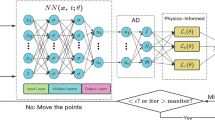Abstract
A least-squares finite-element method (LSFEM) for the non-conservative shallow-water equations is pre- sented. The model is capable of handling complex topography, steady and unsteady flows, subcritical and supercritical flows, and flows with smooth and sharp gradient changes. Advantages of the model include: (1) sources terms, such as the bottom slope, surface stresses and bed frictions, can be treated easily without any special treatment; (2) upwind scheme is no needed; (3) a single approximating space can be used for all variables, and its choice of approximating space is not subject to the Ladyzhenskaya-Babuska-Brezzi (LBB) condition; and (4) the resulting system of equations is symmetric and positive-definite (SPD) which can be solved efficiently with the preconditioned conjugate gradient method. The model is verified with flow over a bump, tide induced flow, and dam-break. Computed results are compared with analytic solutions or other numerical results, and show the model is conservative and accurate. The model is then used to simulate flow past a circular cylinder. Important flow characteristics, such as variation of water surface around the cylinder and vortex shedding behind the cylinder are investigated. Computed results compare well with experiment data and other numerical results.
Similar content being viewed by others
References
Abbot M.B., Damsgaard A., Rodenhuis G.S.: SYSTEM 21, “Jupiter”, A design system for two-dimensional nearly horizontal flows. J. Hydraul. Res. 11, 1–28 (1973)
Causon D.M., Ingram D.M., Mingham C.G., Yang G., Pearson R.V.: Calculation of shallow water flows using a Cartesian cut cell approach. Adv. Water Resour. 23, 545–562 (2000)
Alcrudo F., Garcia-Navarro P.: A high resolution Godunov-type scheme in finite volume for the 2D shallow water equation. Int. J. Numer. Meth. Fluids 16, 489–505 (1993)
Alessandro V., Caleffi V., Zanni A.: Case study: Malpasset dam-break simulation using a two-dimensional finite volume method. ASCE J. Hydraul. Eng. 128(5), 460–472 (2002)
Cheng R.T.: Modeling of hydraulic systems by finite element methods. Adv. Hydrosci. 11, 207–284 (1978)
Gracia R., Kahawita R.A.: Numerical solution of the St. Venant equations with the MacCormack finite element scheme. Int. J. Numer. Meth. Fluids 6, 507–527 (1986)
Fujihara M., Borthwick A.G.L.: Godunov-type solution of curvilinear shallow-water equations. ASCE J. Hydraul. Eng. 126, 827–836 (2000)
Stansby P.K., Zhou J.G.: Shallow-water flow solver with non-hydrostatic pressure: 2D vertical plane problems. Int. J. Numer. Meth. Fluids 28, 541–563 (1998)
Zhou J.G.: A lattice Boltzmann model for the shallow water equations. Comput. Methods Appl. Mech. Eng. 191, 3527–3539 (2002)
Deang J.M., Gunzburger M.D.: Issues related to least-squares finite element methods for the Stokes equations. SIAM J. Sci. Comput. 20(3), 878–906 (1998)
Bochev P.B., Gunzburger M.D.: Finite element methods of least-squares type. SIAM Rev. 40(4), 789–837 (1998)
Gerritsma M.I., Proot M.M.J.: Analysis of a discontinuous least squares spectral element method. J. Sci. Comput. 17(1-4), 297–306 (2002)
Gunzburger M.D.: Finite Element Methods for Viscous Incompressible Flows. Academic Press, Boston (1989)
Girault V., Raviart P.: Finite Element Methods for Navier–Stokes Equations: Theory and Algorithm. Springer, Berlin (1986)
Carey G.F., Jiang B.N.: Element-by-element linear and nonlinear solution scheme. Commun. Appl. Numer. Meth. 2, 145–153 (1986)
Liang, S.J., Jan, Y.J.: Numerical analysis of mass conservation of the L 2 least-squares finite element methods for Stokes equations. In: Proceedings of the 5th Osaka Colloquium, Osaka, Japan, pp. 14–15 (2005)
Liang S.J., Jan Y.J.: Numerical analysis of mass conservation property of the L 2 least-squares finite-element methods for Navier–Stokes equations. J. Aeronaut. Astronaut. Aviat. 38, 199–205 (2006)
Tang, J.H., Chen, C.F.: Numerical simulation of free overfall. The 9th National Computational Fluid Dynamics Conference, Tainan, Taiwan, pp. 496–503 (2002)
Yulistiyanto B., Zech Y., Graf W.H.: Flow around a cylinder: Shallow-water modeling with diffusion-dispersion. ASCE J. Hydraul. Eng. 124(4), 419–429 (1998)
Jiang B.N.: The Least-Squares Finite Element Method. Springer, Berlin (1998)
Reddy J.N.: Energy Principles and Variational Methods in Applied Mechanics, 2nd edn. Wiley, New York (2002)
Laibel J.P., Pinder G.F.: Least squares collocation of differential equations on irregularly shaped domain using orthogonal meshes. Numer. Methods Partial. Diff. Eqs. 5, 347–361 (1989)
Toro E.: Shock-Capturing Methods for Free-Surface Shallow Flows. Wiley, New York (2001)
Mingham C.G., Causon D.M.: High-resolution finite-volume method for shallow water flows. ASCE J. Hydraul. Eng. 124(6), 605–614 (1998)
Fennema R.T., Chaudhry M.H.: Explicit methods for 2D transient free-surface flows. ASCE J. Hydraul. Eng. 116(11), 1013–1034 (1990)
Glaister P.: Flux difference splitting for open channel flows. Int. J. Numer. Meth. Fluids 16, 629–654 (1993)
Coutanceau M., Bouard R.: Experimental determination of the main features of the viscous flow in the wake of a circular cylinder in uniform transition. Part I: Steady flow. J. Fluid Mech. 79, 231–256 (1977)
Dennis S.C.R., Chang G.Z.: Numerical solution for steady flow past a circular cylinder at Reynolds number up to 100. J. Fluid Mech. 42, 471–489 (1970)
Author information
Authors and Affiliations
Corresponding author
Rights and permissions
About this article
Cite this article
Liang, SJ., Tang, JH. & Wu, MS. Solution of shallow-water equations using least-squares finite-element method. Acta Mech Sin 24, 523–532 (2008). https://doi.org/10.1007/s10409-008-0151-4
Received:
Revised:
Accepted:
Published:
Issue Date:
DOI: https://doi.org/10.1007/s10409-008-0151-4




